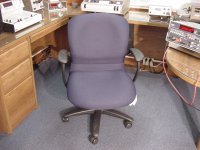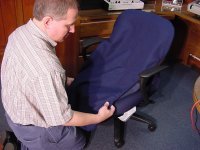Personnel
in Call Centers around the world report being shocked as they perform
their jobs. These hocks typically are to the head area near the headsets
they wear. Where else but call centers would one find several hundred
people in an office environment tethered to a grounded telephone system
by headsets? The phenomena are real and so are the effects on the
personnel.
 The
reported problems due to these shocks range from mild annoyance to
loss of sight and hearing. Luckily the more drastic affects seem to
be temporary.These are electrostatic shocks primarily of the person
to the phone system. Typically the electrical or telecommunication
systems are not to blame as the source of the electrostatic voltages
which result in the painful shocks.
The
reported problems due to these shocks range from mild annoyance to
loss of sight and hearing. Luckily the more drastic affects seem to
be temporary.These are electrostatic shocks primarily of the person
to the phone system. Typically the electrical or telecommunication
systems are not to blame as the source of the electrostatic voltages
which result in the painful shocks.
 Sometimes
the source may be atmospheric in nature. Lightning in the general
area may cause what experts call a "ground plane rise" and
give a shock to persons wearing headsets. However, this is a more
rare phenomenon if the system has proper surge protection. We investigated
in several call centers the shocks caused by electrostatic charges
accumulated on the personnel and discharged to other persons, the
equipment or through the headsets.
Sometimes
the source may be atmospheric in nature. Lightning in the general
area may cause what experts call a "ground plane rise" and
give a shock to persons wearing headsets. However, this is a more
rare phenomenon if the system has proper surge protection. We investigated
in several call centers the shocks caused by electrostatic charges
accumulated on the personnel and discharged to other persons, the
equipment or through the headsets.
Causes:
The primary causes of the electrostatic charge are personnel actions
and clothing in relationship with the call center floors and chairs.
In other words, the personnel themselves charge up their bodies
because they wear clothes and shoes, which generate electrostatic
charges when they scoot in and stand up from their chairs and when
they walk on the floors. When this charge reaches enough potential
(voltage) on the person to jump the gap between their ear and the
headset, a shock occurs. Most headsets have some sort of insulative
piece that cushions the ear to the headset speaker. The distance of
this will hold off and arc of approximately 20,000 to 35,000 volts
on the person. This means that by the time the electrostatic potential
is great enough to jump, it is sufficient to cause physical pain.
Most
call centers have normal office style chairs, which have no antistatic
capabilities. Also most call centers have normal carpeted floors with
carpet that has little ability to keep static charges down against
many shoe types.
 Floors:
Floors:
When a carpet is sold as "antistatic",
it means that it has been tested at 20% RH against a standard Neolite
sole sandal and found to be below 3,000 volts. This does not guarantee
that the voltages on a person at any other humidity or wearing any
other shoe will be less than 3,000 volts. In fact many shoes tested
against "antistatic" carpets have much higher results. Most
people can not feel below 3,500 volts when they discharge from their
fingers such as getting out of a car or walking across a carpeted
floor and touching a doorknob. However, when such a discharge
is allowed to occur at the ear lobe area, the sensitivity is much
greater.
Better
carpet from an antistatic point of view is needed when personnel are
wearing telephone headsets. The
application of antistatic chemicals to standard "antistatic"
carpet will keep personnel voltages down but it is a temporary fix
that must be reapplied every few months. The best carpet for the
reduction of charges is conductive. This means that the carpet
is made with conductive fibers allowing it to discharge static charges
from the shoes of personnel. Our labs have tested carpets in very
low humidities with insulative shoes and found that they provide a
very low static generation for call center environments.
Shoes:
Personnel add considerably to their electrostatic charging by the
shoes they wear. Leather soled shoes are usually better than shoes
with rubber soles. However, when conductive carpet is used with conductive
footwear such as heel grounders or ESD shoes, the voltage on a person
is kept below 100 volts. When
most normal shoes are worn, conductive carpets generally keep the
voltage on personnel below 1,500 volts which is well below the perception
of pain during a discharge.
Chairs:
Normal office style chairs have polyester upholstery and have no means
of grounding the chair. In the electronics industry where computer
chips may be sensitive to a few volts, the chairs are conductive and
have grounding mechanisms. In normal office chairs, when a person
sits in and scoots around in the chair then stands up, they accumulate
a significant electrostatic charge which may then discharge through
the telephone headset or to another worker. If that other worker just
stood up from their chair and walked over on non-conductive carpeting,
the potential difference or the total voltage between the two people
may double because the voltages may add. In this case the shock would
also be doubled in intensity and also may cause two people discomfort.
In call centers conductive chairs should be used. These chairs are
usually very expensive and by the time the problem is known the call
center usually has already purchased several hundred chairs.

 Chairs
Covers:
Chairs
Covers:
One alternative
to buying a conductive chair is to use a conductive cover, which has
conductive threads woven into it. Our lab tested conductive covers
and found that they keep the voltages on persons below about 1/5th
that of the plain chair.
Clothes:
Of course the clothes that a person wears are very important to how
much electrostatic charges are generated by the person. Oddly enough,
cotton clothes, which are normally very good from an electrostatic
point of view, may charge more against a polyester upholstered chair
than blended fabrics. One method of keeping the voltage due to clothing
on a person down is to require the personnel to wear conductive lab
coats. This in combination with the chairs would disallow the kind
of potentials now experienced in the call centers.
Every call center has a unique situation for electrostatic problems.
A survey of the needs should be performed prior to any actions. However,
if all the main variables are controlled:
Chairs, Floor, Clothes and Shoes
the problem should go away painlessly.

